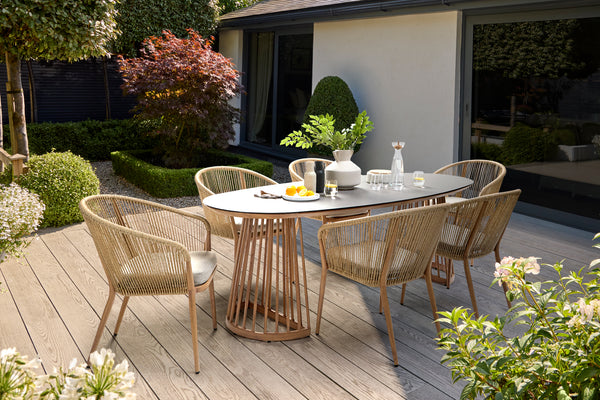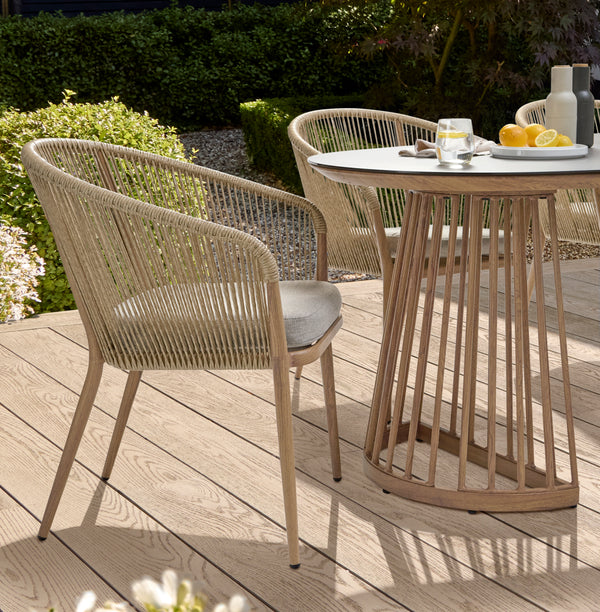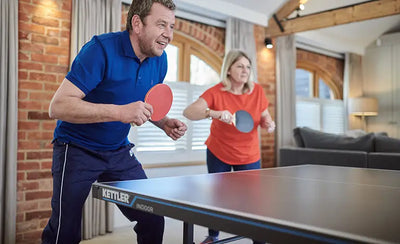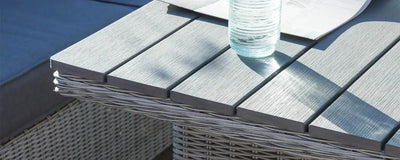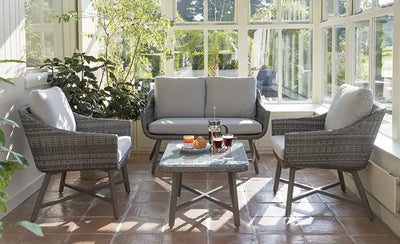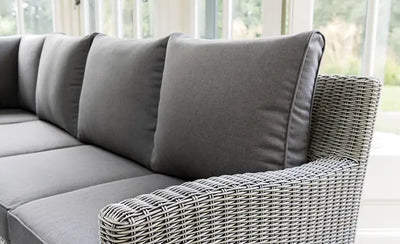
What is the best material for garden furniture?

Garden Furniture Materials Guide
From lounge chairs to outdoor sofas, garden furniture is built to withstand fluctuating weather all year round thanks to a range of durable materials.
There are four main materials that stand out, with each one having pros and cons. Struggling to decide which is best for your garden? Our garden furniture materials buying guide is here to help you make that final decision.
Things to Think About
Before we get to the exciting stage, we need to first run through some important considerations, particularly surrounding the style of your garden.
- What aesthetic are you aiming for? i.e. contemporary or traditional?
- Where will the furniture be placed? Will the furniture go on a patio, decking area or conservatory?
- What is the size of your space? Larger spaces provide more flexibility with the furniture you choose, some of which may only be available in certain materials.
- Do you need a dining set, lounge set or a mix of the two?
Wicker
KETTLER Wicker is suitable for both traditional and contemporary gardens as well as inside a conservatory. You may know it as rattan, but we call it wicker and our wicker comes in a choice of colours. Our Palma sets from the Palma range (pictured below), for example, include the colours Oyster or White Wash.

What is Wicker?
Wicker is woven fibre which goes over an aluminium frame. Synthetic wicker lasts longer with better weatherproof durability for season after season of enjoyment. From flat wicker to D-weave to half round; the choice of different wicker weaves makes a big difference with a specific look and feel. Round wicker and half round wicker features more robust qualities, however flat wicker feels smoother to touch.
Wicker furniture is often bulky, with large armrests and boxy designs, so make sure you have the space for it. Wicker sets can go outside and inside of both contemporary and traditional locations, with lounge and dining sets available.
Pros of Wicker Furniture
- Naturally weather resistant.
- Relatively low maintenance.
- Long-lasting and hardwearing.
- Lightweight for easy manoeuvrability.
- Looks great in modern and traditional gardens.
Cons of Wicker Furniture
- Wicker furniture tends to be larger than average.
- The material is stiff and offers little flexibility.
- Wicker tends to cost more due to materials and manufacturing process.
Wood
Wooden garden furniture can go on a patio, decking area or a gravelled area and sits beautifully in a lush green garden due to the organic material. KETTLER uses hardwood for a longer lasting furniture set with natural resistance to the outdoor elements.
A versatile material, wooden garden furniture can look rustic and worn or smooth and shiny. For example, the Hampton range (pictured below) contains pieces that offer a traditional, mid-century modern look, while the Fiji Lounge set is a great option for more modern environments.

The wood we use is either teak, acacia or eucalyptus based. All of these woods are dense, tough materials with no warping and increased resistance to rot. To keep wooden furniture in top shape, a yearly treatment of oil protects outer layers and restores moisture to the material beneath.
In addition, all the wood we use is FSC (Forest Stewardship Council) certified, meaning it has been harvested in an environmentally-friendly manner.
Pros of Wood Furniture
- Provides an authentic appearance.
- Lasts long with proper maintenance.
- Can often be recycled.
Cons of Wood Furniture
- Can quickly become damaged.
- Prone to warping over time.
- Requires frequent cleaning to avoid rot.
- Requires regular maintenance
Metal
Metal furniture is a classic style for traditional gardens. KETTLER’s metal range has been a popular choice for decades, withstanding season after season. Metal garden furniture is often simple, with clean designs and coming with an optional tailored cushion.
Need something foldable or stackable? Metal might be the choice for you. Both variants offer a tidy storage option without the need for dedicated storage space. Foldable designs include smaller sets which sit on a balcony or a small patio. For a closer look at the options we have, take a look at our metal furniture category, specifically the Café Roma range (pictured below).

Metal furniture frequently comes in a mesh design to provide additional structure support. This involves a cross-hatched design that provides both ventilation and strength. Mix and match armchairs and side chairs with mesh tables with parasols to buy as accessories for the perfect mesh garden furniture set at KETTLER.
Pros of Metal Garden Furniture
- Tough and long-lasting against harsh weather.
- Resistant to fire damage.
- Requires little maintenance.
- Easily stored away.
Cons of Metal Garden Furniture
- Absorbs heat from long-term sun exposure.
- Can cause damage to floors.
- Prone to rusting and corrosion.
Aluminium
Aluminium is a lightweight, and durable material. It is used frequently on garden furniture thanks to its resistance to rust. Such pieces are usually populated with textilene cushions to add a touch of comfort to an otherwise rigid piece.
The elba collection (pictured below) for example featured backrests and seat cushions made with a textilene material.

With so many styles available, aluminium furniture can be used on dining sets for deckings, patios, and even indoors.
Pros of Aluminium
- Rust resistant.
- Lightweight.
- Requires little maintenance.
Cons of Aluminium
- Typically, higher priced
- Heats up quickly in direct sunlight.
Care Advice
For information on how to look after and prolong the life of your furniture, no matter what material you use, have a read through our garden furniture care advice.
Robust Garden Furniture from KETTLER
If you’re in need of highly durable garden furniture, look no further than KETTLER. We stock ranges created in only the toughest of materials to ensure a long-lasting fit all year round.




